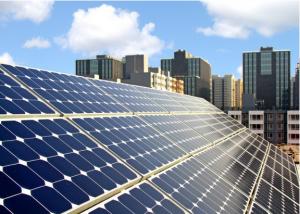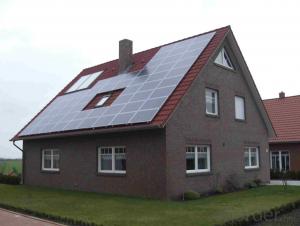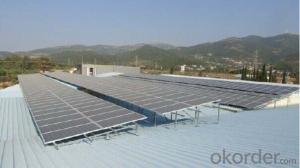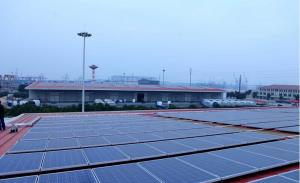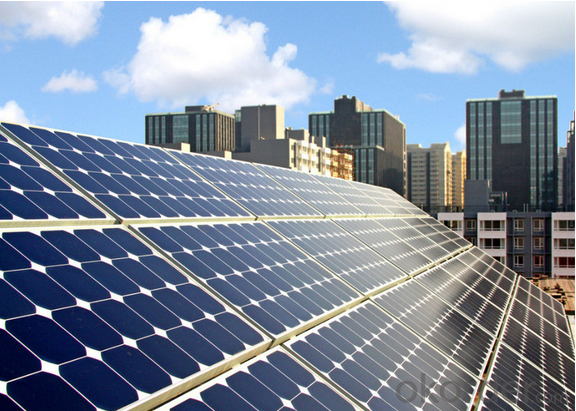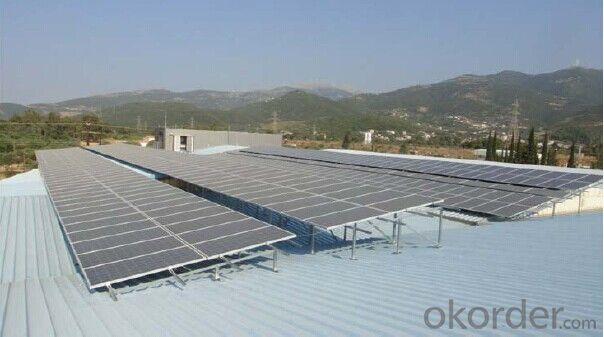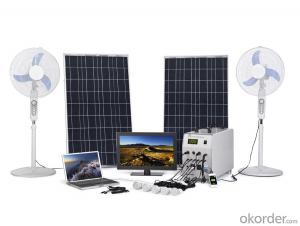Complete Solar System for Home Solar Panel System Home 5KW
- Loading Port:
- Guangzhou
- Payment Terms:
- TT or LC
- Min Order Qty:
- 10 set
- Supply Capability:
- 100000 set/month
OKorder Service Pledge
OKorder Financial Service
You Might Also Like
Complete Solar System for Home Solar Panel System Home 5kw
Features of Complete Solar System
Solar module:solar battery module(also called photovoltaic battery module)in series or in parallel according to the system requirements,the solar energy will change into electrical energy in the light of the sun and then output,it is the core component of solar photovoltaic system.
Controller: solar power controller is an important part of the solar power system, System of charging and discharging and load work automatically by its intelligent control and protection. Its performance directly affects the reliability of the system. Especially the battery life, overcharge or over discharge will be cause damage and even lethal damage for the battery.
Inverter: in solar photovoltaic power supply system, if it has the AC load, it is necessary to use the devices of the inverter. The direct current generated by solar modules or the battery release of DC into AC for load.
Battery:Stored up the electricity produced by the solar cell module produce,When illumination is insufficient or night or load demand is greater than the power produced by the solar cell module.Stored energy will be released in order to meet the load demand of energy,It is the solar energy photovoltaic system energy storage unit.Currently solar pv system commonly used is lead acid battery,For higher requirements of the system,Usually adopt deep discharge vrla battery ,deep discharge suction fluid type lead-acid battery,etc
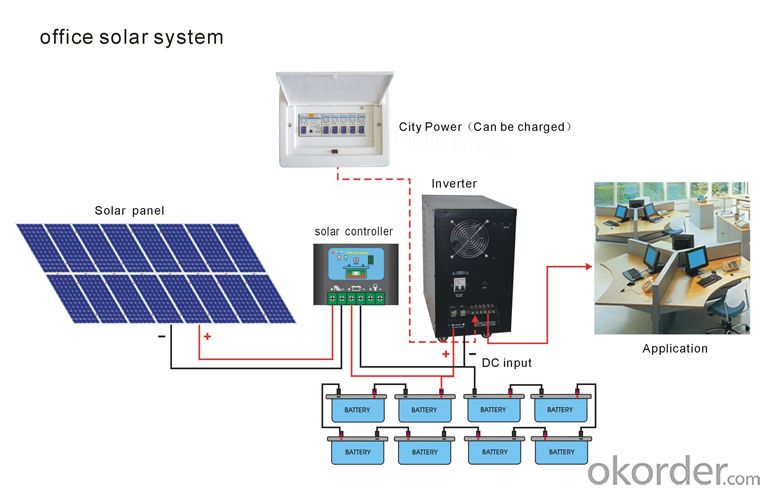
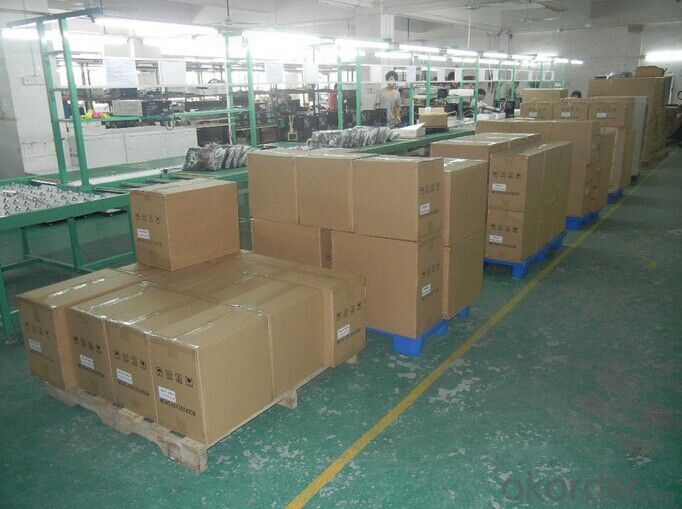
Product Parameter
Model XD- | TNY50112-10 | TNY70112-50 | TNY10224-50 | TNY20248-40 | TNY50296-50 | |||
Solar Energy Module | Type | Monocrystalline silicon A level | ||||||
Power | 100W | 500W | 1100W | 1800W | 4400W | |||
Daily Power generation | 0.5KWH | 2.5KWH | 5.5KWH | 9KWH | 22KWH | |||
Size(mm) | 1160×660×35×1 | 1250*660*35*4 | 1360*900*40*6 | 1620*990*40*8 | 1955*990*45*16 | |||
PV Controller | Control mode | Direct charge/PWM/MPPT | ||||||
Charge current | 10A | 50A | 50A | 40A | 50A | |||
Rated charging voltage | 12VDC | 12VDC | 24VDC | 48VDC | 96VDC | |||
Compulsive charging voltage | 14.8V | 29.6V | 59.2V | 118.4V | ||||
Balanced charging voltage | 14.4V | 28.8V | 57.6V | 115.2V | ||||
Floating charging voltage | 13.8V | 27.6V | 55.2V | 110.4V | ||||
Recovery charging voltage | 13.3 | 26.6V | 53.2V | 106.4V | ||||
Battery overvoltage protection/recovery | 16.5V/15V | 33V/30V | 66V/60V | 132V/120V | ||||
Protection function | Reverse connection, short circuit, overcharge, anti charge protection | |||||||
Display | LED | |||||||
PV Inverter | Rated Capacity | 500W | 700W | 1000W | 2000W | 5000W | ||
DC voltage | 12V | 24V | 48V | 96V | ||||
Undervoltage protection | 10.5V | 21V | 42V | 84V | ||||
Inverter structure | Low frequency structure | |||||||
Mains input | 75VAC-125VAC or 145VAC-275VAC | |||||||
Inverter output | 110VAC+/-2% or 220VAC+/-2% | |||||||
Mains input charging current | 10A | |||||||
Working way | Mains priority/solar power priority (optional) | |||||||
Conversion time | ≤4ms | |||||||
Overload capacity | Overload 110% 30 seconds the machine automatically shut down; overload shutdown 120% 2 seconds; mains mode overload do not shutdown | |||||||
Conversion efficiency | ≥80% | |||||||
Output waveform | Pure sine wave | |||||||
Work environment | Temperature0-40℃,Humidity10-90% | |||||||
Cooling mode | Forced air cooling | |||||||
Protection function | Mains over / under-voltage, direct current is too high / undervoltage, the inverter output short circuit | |||||||
Display | LCD | |||||||
Output waveform distortion | ≤±0.3% | |||||||
Input and output frequency | The same with power system | |||||||
Battery | Battery Type | Deep cycle maintenance-free lead-acid battery | ||||||
Battery capacity | 100AH/12V×1 | 200AH/12V×1 | 100AH/12V×2 | 200AH/12V×4 | 100AH/12V×8 | |||
Discharge time(full Load calculation) | 1.3H | 1.8H | 1.3H | 2.8H | 1.1H | |||
Machine specifications | Size(mm) | 465×245×465 | 580×280×470 | 580×300×610 | 600×540×940 | |||
Weight | 48KG | 81KG | 7KG | 302KG | 332KG | |||
Remarks | Specification for reference.Subject to change without prior notice | |||||||


- Q:Can solar energy systems be used for powering electric vehicles?
- Yes, solar energy systems can be used to power electric vehicles. Solar panels can generate electricity from sunlight, which can then be stored in batteries or directly used to charge the vehicle's battery pack. This allows for a clean and renewable source of energy to power electric vehicles, reducing reliance on fossil fuels and decreasing greenhouse gas emissions.
- Q:Can solar energy systems be used during power outages?
- Yes, solar energy systems can be used during power outages, as long as they are equipped with battery storage. The batteries store excess solar energy generated during the day, allowing it to be used at night or during power outages. This provides a reliable source of electricity even when the grid is down.
- Q:What is the role of solar energy systems in achieving energy independence?
- Solar energy systems play a critical role in achieving energy independence by harnessing the power of the sun to generate clean and renewable electricity. They contribute to reducing reliance on fossil fuels, decreasing greenhouse gas emissions, and diversifying the energy mix. Solar energy systems allow individuals, communities, and even entire nations to generate their own electricity, reducing the need for importing energy from other sources. By promoting energy self-sufficiency, solar power systems contribute to greater energy independence and sustainability.
- Q:Can solar energy systems be used in areas with high levels of seismic activity?
- Yes, solar energy systems can be used in areas with high levels of seismic activity. These systems are designed to withstand various environmental conditions, including earthquakes. The mounting structures and panels are engineered to be flexible and durable, allowing them to withstand the vibrations and movements caused by seismic events. Additionally, solar energy systems do not have any moving parts, reducing the risk of damage during earthquakes.
- Q:How do solar energy systems impact energy independence?
- Solar energy systems can greatly impact energy independence by reducing reliance on traditional energy sources such as fossil fuels. By harnessing the power of the sun, solar energy systems provide a clean and renewable source of electricity. This reduces the need to import energy from other countries, enhancing a nation's energy independence. Additionally, solar energy systems can be installed at individual homes and businesses, allowing individuals to generate their own electricity and become less dependent on the grid. Overall, solar energy systems play a crucial role in promoting energy independence and reducing the carbon footprint.
- Q:How do solar energy systems impact roof maintenance and repairs?
- Solar energy systems can have both positive and negative impacts on roof maintenance and repairs. On one hand, the installation of solar panels can provide an additional layer of protection to the roof, shielding it from the elements and prolonging its lifespan. However, roof maintenance becomes more challenging as solar panels need to be temporarily removed or adjusted during inspections or repairs. Additionally, the installation process itself may cause minor damage to the roof, which should be promptly addressed to prevent any long-term issues. Overall, proper planning, regular inspections, and timely repairs are crucial to ensure the optimal performance of both the solar energy system and the roof.
- Q:Can solar energy systems be used in areas with limited sunlight hours?
- Solar energy systems can indeed be utilized in regions with minimal sunlight hours. Although solar panels generate the highest amount of energy when directly exposed to sunlight, advancements in technology have made it feasible for solar systems to still produce electricity even in areas with limited sunlight. One method to tackle the issue of limited sunlight hours is by installing solar panels that are more efficient at capturing and converting sunlight into electricity. These high-efficiency solar panels can optimize energy production even in areas with reduced sunlight. Additionally, the utilization of tracking systems that tilt and follow the sun's path throughout the day can also aid in increasing energy output. Another approach involves storing excess energy generated during peak sunlight hours in batteries. This stored energy can then be utilized during periods of low sunlight, enabling the solar system to continue powering homes or businesses even in the absence of sunlight. Furthermore, integrating solar power with other renewable energy sources, such as wind or hydroelectric power, can help compensate for limited sunlight hours. By combining different sources, a more reliable and consistent energy supply can be achieved. In conclusion, although limited sunlight may impact the energy production of solar systems, there are numerous technological solutions and strategies that can be employed to make solar energy feasible even in areas with fewer sunlight hours.
- Q:Can solar energy systems be used in powering electric fences or security systems?
- Yes, solar energy systems can certainly be used in powering electric fences or security systems. Solar panels can generate electricity by converting sunlight into energy, which can then be stored in batteries or used directly to power various devices. This makes solar energy systems a practical and sustainable choice for powering electric fences or security systems, especially in remote or off-grid locations where traditional power sources may be unavailable or unreliable. Solar-powered electric fences can effectively deter intruders or keep animals within a designated area, while solar-powered security systems can provide continuous surveillance and monitoring without the need for a constant supply of electricity. Additionally, solar energy systems are environmentally friendly and can help reduce carbon emissions associated with conventional power sources, making them an increasingly popular and cost-effective solution for powering various applications, including electric fences and security systems.
- Q:How often do solar panels need to be cleaned?
- Solar panels generally need to be cleaned at least once or twice a year to ensure optimal performance. However, the frequency of cleaning can vary depending on factors such as the local climate, amount of dust or debris accumulation, and the tilt angle of the panels. Regular inspections and maintenance can help determine the specific cleaning needs of solar panels.
- Q:Solar power generation system how to choose?
- Solar power generation technology is now very mature, the most important choice is to generate sufficient power, stable operation, reliable warranty and after-sales service.
1. Manufacturer Overview |
|
|---|---|
| Location | |
| Year Established | |
| Annual Output Value | |
| Main Markets | |
| Company Certifications | |
2. Manufacturer Certificates |
|
|---|---|
| a) Certification Name | |
| Range | |
| Reference | |
| Validity Period | |
3. Manufacturer Capability |
|
|---|---|
| a)Trade Capacity | |
| Nearest Port | |
| Export Percentage | |
| No.of Employees in Trade Department | |
| Language Spoken: | |
| b)Factory Information | |
| Factory Size: | |
| No. of Production Lines | |
| Contract Manufacturing | |
| Product Price Range | |
Send your message to us
Complete Solar System for Home Solar Panel System Home 5KW
- Loading Port:
- Guangzhou
- Payment Terms:
- TT or LC
- Min Order Qty:
- 10 set
- Supply Capability:
- 100000 set/month
Offcanvas right
OKorder Service Pledge
OKorder Financial Service
Similar products
New products
Hot products
Hot Searches
Related keywords

